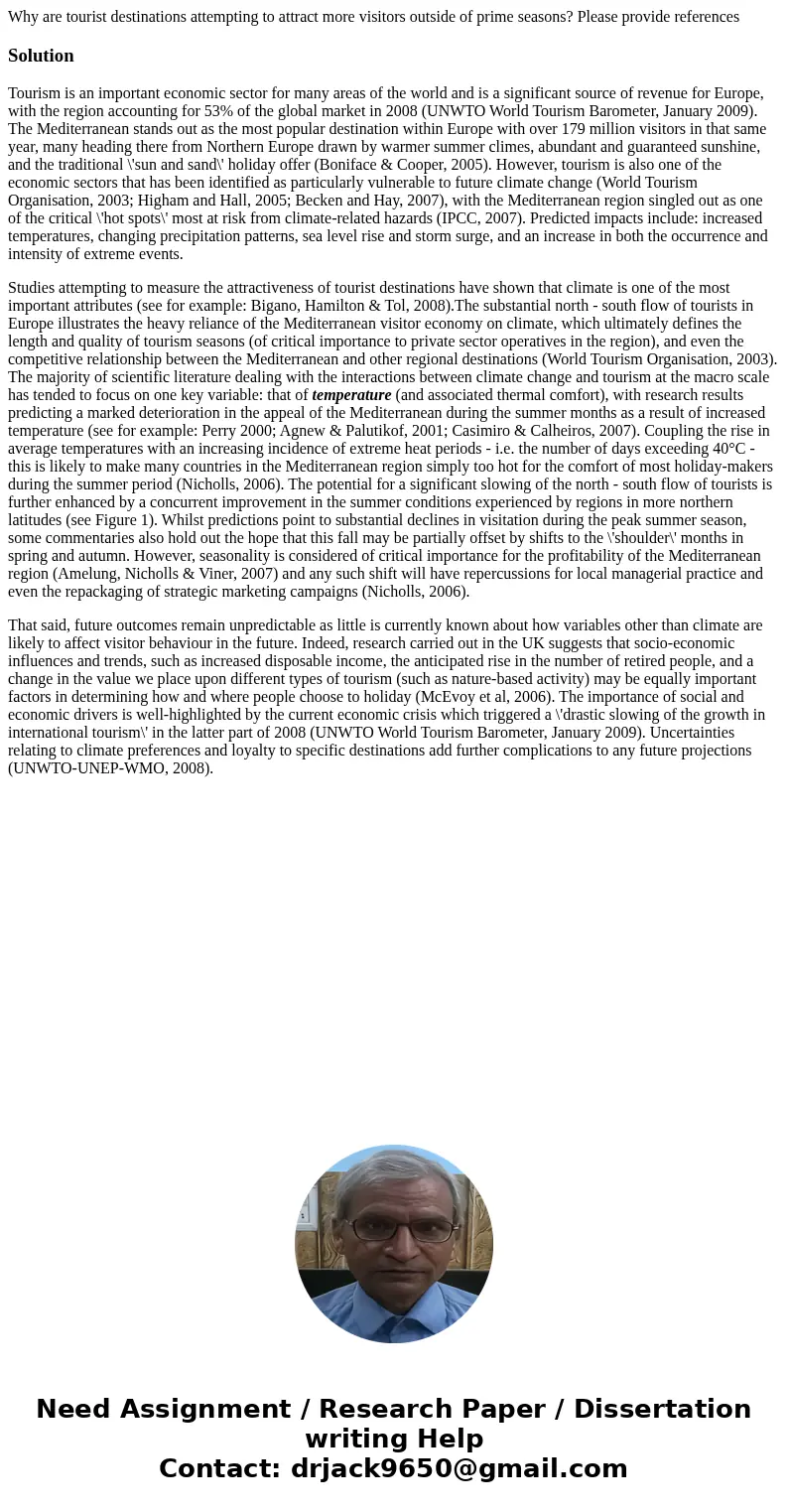Why are tourist destinations attempting to attract more visi
Why are tourist destinations attempting to attract more visitors outside of prime seasons? Please provide references
Solution
Tourism is an important economic sector for many areas of the world and is a significant source of revenue for Europe, with the region accounting for 53% of the global market in 2008 (UNWTO World Tourism Barometer, January 2009). The Mediterranean stands out as the most popular destination within Europe with over 179 million visitors in that same year, many heading there from Northern Europe drawn by warmer summer climes, abundant and guaranteed sunshine, and the traditional \'sun and sand\' holiday offer (Boniface & Cooper, 2005). However, tourism is also one of the economic sectors that has been identified as particularly vulnerable to future climate change (World Tourism Organisation, 2003; Higham and Hall, 2005; Becken and Hay, 2007), with the Mediterranean region singled out as one of the critical \'hot spots\' most at risk from climate-related hazards (IPCC, 2007). Predicted impacts include: increased temperatures, changing precipitation patterns, sea level rise and storm surge, and an increase in both the occurrence and intensity of extreme events.
Studies attempting to measure the attractiveness of tourist destinations have shown that climate is one of the most important attributes (see for example: Bigano, Hamilton & Tol, 2008).The substantial north - south flow of tourists in Europe illustrates the heavy reliance of the Mediterranean visitor economy on climate, which ultimately defines the length and quality of tourism seasons (of critical importance to private sector operatives in the region), and even the competitive relationship between the Mediterranean and other regional destinations (World Tourism Organisation, 2003). The majority of scientific literature dealing with the interactions between climate change and tourism at the macro scale has tended to focus on one key variable: that of temperature (and associated thermal comfort), with research results predicting a marked deterioration in the appeal of the Mediterranean during the summer months as a result of increased temperature (see for example: Perry 2000; Agnew & Palutikof, 2001; Casimiro & Calheiros, 2007). Coupling the rise in average temperatures with an increasing incidence of extreme heat periods - i.e. the number of days exceeding 40°C - this is likely to make many countries in the Mediterranean region simply too hot for the comfort of most holiday-makers during the summer period (Nicholls, 2006). The potential for a significant slowing of the north - south flow of tourists is further enhanced by a concurrent improvement in the summer conditions experienced by regions in more northern latitudes (see Figure 1). Whilst predictions point to substantial declines in visitation during the peak summer season, some commentaries also hold out the hope that this fall may be partially offset by shifts to the \'shoulder\' months in spring and autumn. However, seasonality is considered of critical importance for the profitability of the Mediterranean region (Amelung, Nicholls & Viner, 2007) and any such shift will have repercussions for local managerial practice and even the repackaging of strategic marketing campaigns (Nicholls, 2006).
That said, future outcomes remain unpredictable as little is currently known about how variables other than climate are likely to affect visitor behaviour in the future. Indeed, research carried out in the UK suggests that socio-economic influences and trends, such as increased disposable income, the anticipated rise in the number of retired people, and a change in the value we place upon different types of tourism (such as nature-based activity) may be equally important factors in determining how and where people choose to holiday (McEvoy et al, 2006). The importance of social and economic drivers is well-highlighted by the current economic crisis which triggered a \'drastic slowing of the growth in international tourism\' in the latter part of 2008 (UNWTO World Tourism Barometer, January 2009). Uncertainties relating to climate preferences and loyalty to specific destinations add further complications to any future projections (UNWTO-UNEP-WMO, 2008).

 Homework Sourse
Homework Sourse